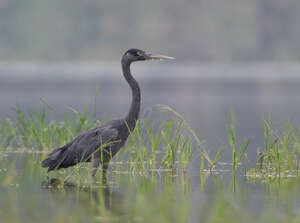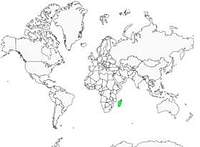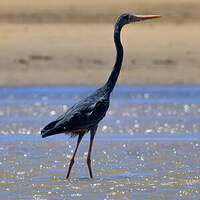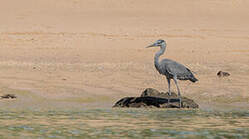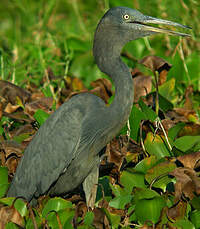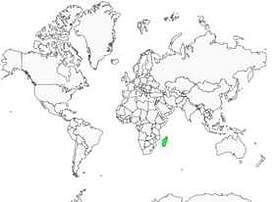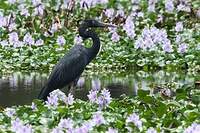Humblot's Heron
Ardea humbloti - Héron de Humblot
Identification
At a glance, this heron looks just like a Grey Heron. With a similar size and wingspan, Humblot's Heron differs by its uniform dark grey colour, without the white areas that a Grey Heron could have. On its head is a nearly black mask. This starts from the forehead and goes down to the neck, ending with two big black feathers. The mask also slightly covers the cheeks. The chin is also black. The pale yellow iris and lores, with no feathers and a greyish-green colour, contrast with the mask. The beak is long and strong, very pale yellow during non-breeding season and tending to orange in breeding season. The rest of the body is grey, with darker remiges. Vaporous feathers on the mantle and the base of the neck are clearer, reminding us of the Ardeidae family. The legs and feet are usually grey-brown. There is no sexual dimorphism in Humblot's Heron. Juveniles look like adults with a dark grey mask instead of black. The throat is white and the beak greyish yellow.
Subspecific information monotypic species
Foreign names
- Héron de Humblot,
- Garza malgache,
- garça-malgaxe,
- Madagaskarreiher,
- madagaszkári gém,
- Madagaskarreiger,
- Airone di Humblot,
- madagaskarhäger,
- Madagaskarhegre,
- volavka masková,
- volavka madagaskarská,
- Askehejre,
- madagaskarinhaikara,
- bernat de Madagascar,
- czapla maskowa,
- Мадагаскарская цапля,
- マダガスカルサギ,
- 马岛鹭,
- madagaskarhäger,
- 馬達加斯加鷺,
Habitat
Behaviour character trait
Humblot's Heron is generally solitary. It feeds alone, rarely forming small colonies. It can stay standing for hours hunting in shallow waters.
On the coast, it takes advantage of the rising and falling tides. Patient fisher, it scans the water with its sharp eyes and detects the slightest movement. With a quick thrust it extends its long neck before in a S shape and grabs its prey with its dagger beak. On strong wind one will see its neck perfectly parallel to the water surface. After catching a large prey, Humblot's Heron will go to swallow on a place with firmer ground. Between each catch, it may also go rest on the beach and clean itself.Dietfeeding habits
Reproduction nesting
Humblot's Heron usually nests alone although sometimes it may settle among colonies of other ardeids.
This will often be with the Grey Heron. It has happened that one can find a Humblot's Heron chick in a Grey Heron nest without knowledge of hybridation or mixed couples. The nest is a simple platform of branches and/or vegetation coming from wet areas which he will choose for his nesting, placed at the top of a tree or among rocks. The female lays 1 to 3 blue eggs that are incubated by both sexes. The breeding period is not very well known, yet it is suspected to take place all year round. As for the reproduction successes, they are however very uncertain. Indeed, it is rare to see juveniles in the areas where it is known that reproduction takes place.Geographic range
Humblot's Heron is endemic to Madagascar and can be seen in the Comoros Archipelago. In Madagascar, it is mainly found along the western coast, in wet areas around the Ampijoroa Forest Reserve, including around Lake Amboromalandy and along the coast between Tuléar and the Onilahy River up to the bay of Saint-Augustin. Its distribution extends from sea level to 1,500 meters above sea level. It has become regular in Mayotte. Sightings are rare on Mohéli, nonexistent on Grand Comore, and uncertain on Anjouan.
Threats - protection
IUCN conservation status
concern
in the Wild
threatened
evaluated
The population of Humblot's Heron had never been quantified but it is known to be very small and endangered. Data from 2003 and 2004 concluded that there are a maximum of 1,500 individuals, or around 1,000 adults. It is listed on the IUCN's Red List and its numbers are constantly declining due to the degradation and overexploitation of its habitat, such as the replacement of wetlands with rice fields in Madagascar. Deforestation on the island has indirectly led to a decrease in its numbers due to the erosion of deforested land filling in shallow waters. Poaching and looting of the nests by local populations are also contributors to this dramatic decrease in numbers. Humblot's Heron breeds in the protected reserves of Madagascar, unfortunately 50% of its population breeds outside these zones and is thus very poorly protected.
Sources of information
- IOC World Bird List (v14.2), Gill, F and D Donsker (Eds). 2024-04-18.
- Les Oiseaux de Mayotte, Clément Michel, Grissac Philippe, Rolland Robin
- The Birds of Africa Vol VIII : The Malagasy Region, Safford R. et Hawkins F.
- ARKive, Christopher Parsons
- BirdLife International, BirdLife International
- GEPOMAY,
Other sources of interest
 Specification sheet created on
25/07/2023 by Nathalie Santa Maria
Specification sheet created on
25/07/2023 by Nathalie Santa MariaTranslation by AI Oiseaux.net
© 1996-2025 Oiseaux.net
- Accipitriformes
- Aegotheliformes
- Anseriformes
- Apodiformes
- Apterygiformes
- Bucerotiformes
- Caprimulgiformes
- Cariamiformes
- Casuariiformes
- Charadriiformes
- Ciconiiformes
- Coliiformes
- Columbiformes
- Coraciiformes
- Cuculiformes
- Eurypygiformes
- Falconiformes
- Galliformes
- Gaviiformes
- Gruiformes
- Leptosomiformes
- Mesitornithiformes
- Musophagiformes
- Nyctibiiformes
- Opisthocomiformes
- Otidiformes
- Passeriformes
- Pelecaniformes
- Phaethontiformes
- Phoenicopteriformes
- Piciformes
- Podargiformes
- Podicipediformes
- Procellariiformes
- Psittaciformes
- Pterocliformes
- Rheiformes
- Sphenisciformes
- Steatornithiformes
- Strigiformes
- Struthioniformes
- Suliformes
- Tinamiformes
- Trogoniformes

